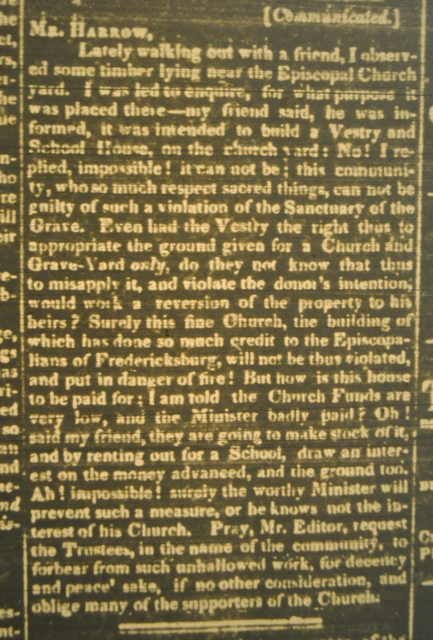

Many people don’t realize that Faulkner Hall was an addition to the church made during the period of the 2nd church (1815-1848). The inside has been remodeled, the latest in 1999 with Aim 2000. The outside has changed – from a Dutch design evident in pictures early in the 20th century to today’s design.
Since our Vestry minutes for most of the 2nd church were destroyed in the Civil War we don’t have the Vestry discussion or decision leading to the building of Faulkner Hall. However there are three letters in the Virginia Herald (July 12, 16, 23) that place Faulkner’s creation in 1823. There was no grand opening story for this building.
The building was created during the McGuire years to be used for Sunday Schools and Vestry meetings. It is still used as a place of Christian education and Vestry meetings.
The term “Sunday School” was not Christian education for the church members but literally schools: they were places were poor children could learn to read. The Sunday school movement began in Britain in the 1780s. Sunday was the only day children didn’t work, working often 12 hours a day on the other days. Thus “Sunday Schools” provided reading of the Bible by copying passages as well as religious-type instruction- prayer and hymn singing.
By the mid-19th century, Sunday school attendance was a near universal aspect of childhood. Even parents who did not regularly attend church themselves generally insisted that their children go to Sunday school. In both Britain and America, universal, compulsory state education was established by the 1870s. After that, reading and writing were learned on weekdays at school and the Sunday school curriculum was limited to religious education.
The reason for the original letter was the concern over building this building over graves (which it was). Apparently, the writer and a friend were walking by the church lying around and noticed timber around. Enclosed grave yards the way we know it was a product of the mid-1850’s though the graveyard did have fences as early as the 1770’s. The building of Faulkner was “violation of the Sanctuary of the Grave.” The writer thought the church was going to rent out the building since funds were low and the “minister badly paid.” The writer appealed to the trustees to end the work.
A response said the writer was badly informed and that it was 3 or 4 years since the Vestry began to consider the building. It was postponed due to the expense. The purpose was to erect a Sunday School to educate the “poor children of our town and neighbourhood in the principles of knowledge and religion.’
The second letter provides some interesting details that are unconfirmed 1. He mentions a donation of a lot. Did the church not originally have this lot with the first church ? 2. The building will be a stock company with investors who will be paid dividends until paid.
The first writer wrote the 3rd letter that the current Vestry are “comparatively strangers among us, and few, if any, have relations buried in our Church Yard.” They may be indifferent but that doesn’t exclude the way they have acted. Why can’t the Sunday School be kept in the church? This writer forecasts “the grave-yard will become a play-ground for the boys; the tombstones be mutilated and broken and the market-house and lot will be a constant scene of tumult and noise during play hours.”
“Sunday Schools” were important during the McGuire years (1813-1858). The Episcopal Sunday School was the first church Sunday School established in this region in 1816. McGuire reported 3 to 5 Sunday Schools, reaching a high point of 350 “scholars” in 1846 taught by 30 teachers.
They were integrated. By 1846 he noted that 2 of 5 Sunday schools were composed of 80 “domestic servants.” and “often taught by the rector.” In Annual Convention, he noted 1 African American communicant.
John Washington, the Fredericksburg slave turned freeman and who grew up across the street at the former Farmers’ Bank (National Bank building), did not have a high opinion of the Sunday Schools in 1852. The schools were in the afternoon and the students were taught the catechism and “verses of the Bible were read to us by heart.” “I do not think much good resulted from this school for we was not permitted to learn the ABC’s or to spell” though he was sent other places where did he learn the skill.
July 12, 1818

July 16, 1818



July 23, 1818



